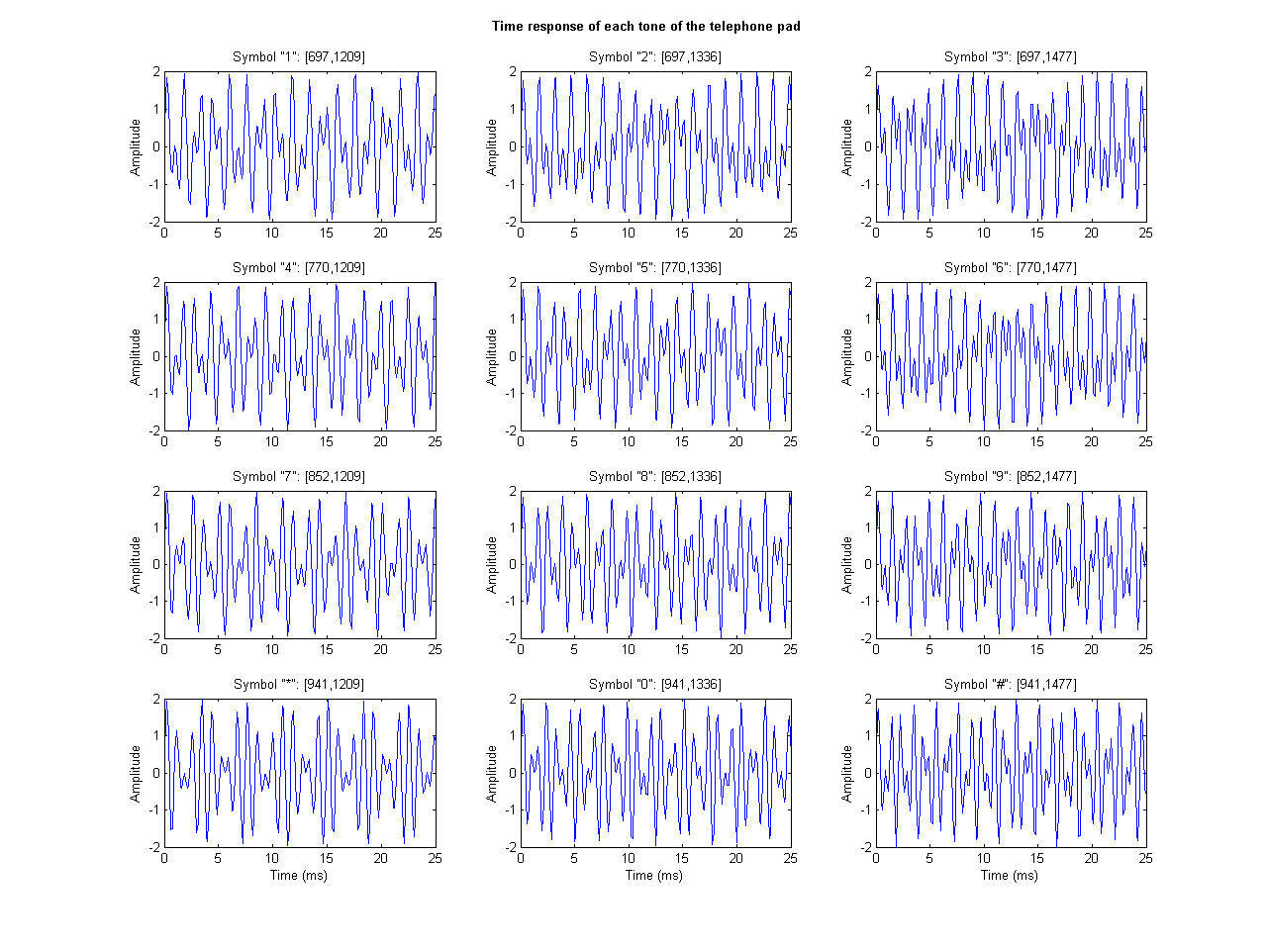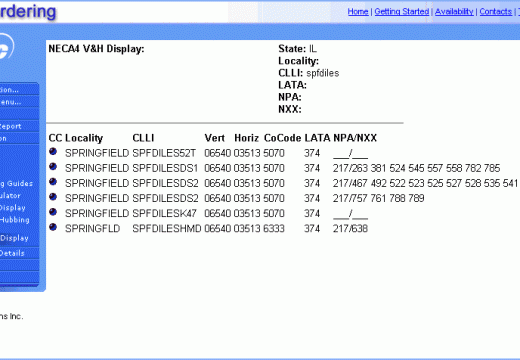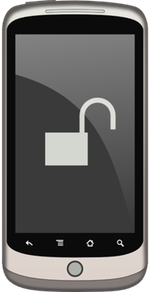The Low Tone is a generic tone used with various interruption patterns for the specific tones listed below:
Line Busy Tone
Reorder
Reverting Tone
No Circuit Tone
No Such Number
Vacant Code
Group Busy Tone
Deposit Coin Tone
Vacant Position Tone
Dial Off-Normal Tone
Trouble Tone
Dial Jack Tone
Dial Test Signal
Class of Service
Low Tone is 480 Hz and 620 Hz at -24 dBm0/frequency. On some systems manufactured before 1974, Low Tone was 600 Hz modulated at 120, 133, 140, or 160 Hz at 61 – 71 dBrnC.
High Tone
The High Tone is a generic tone used with various interruption patterns for the specific tones listed below and described under their own titles:
Partial Dial Tone
Permanent Signal
Coin Return (Test) Tone
Coin Return Tone
Number Checking Tone
Intercepting Loopback Tone
Warning Tone
Order Tone
Station Ringer Test
Class of Service
High Tone is 480 Hz at -17 dBm0. On some systems manufactured before 1974, High Tone was 400 Hz or 500 Hz at 61 – 71 dBrnC.
Dial Tone
Dial Tone is sent to a customer or operator to indicate that the receiving end is ready to receive dial pulses or DTMF signals. It is used in all types of dial offices when the customer’s or operator’s dials produce dial pulses. Normally, dial tone means that the entire wanted number may be dialed. However, there are some cases where the calling party must await a second dial tone or where an operator, after dialing an initial group of digits, must wait for a second dial tone before the rest of the number can be dialed. Some dialing switchboards are arranged to permit listening for dial tone between certain digits.
Dial Tone is 350 Hz and 440 Hz held steady at -13 dBm0/frequency.

Audible Ring Tone
Audible Ring Tone is a ringing indication that the calling party intercepts to mean that the called line has been reached and that the ringing has started. It is also used on calls to operators (special service, long distance, intercepting, etc.) during the “awaiting-operator-answer” interval.
Audible Ring Tone is 440 Hz and 480 Hz for 2 seconds on and 4 seconds off at -13 dBm0/frequency.
Line Busy Tone
The Line Busy Tone indicates that the called customer’s line has been reached but that it is busy, being rung, or on permanent signal. When an operator applies a line busy signal, it is sometimes called a busy-back tone.
Line Busy Tone is a Low Tone that is on and off every .5 seconds.
Reorder
The Reorder Tone indicates that the local or toll switching or transmission paths to the office or equipment serving the called customer is busy. This signal may indicate a condition such as a timed-out sender or unassigned code dialed. Either a customer or an operator interprets it as a reorder signal.
Reorder on a local call is Low Tone for .3 seconds on and .2 seconds off. Reorder on a toll call is Low Tone for .2 seconds on and .3 seconds off. In No. 5 crossbar, No. 1/1A ESS, No. 2/2B ESS switching equipment, and No. 1 step-by-step offices using the Precise Tone Plan, the temporal pattern is 0.25 second of low tone and 0.25 second off.
Alerting Tone
The Alerting Tone indicates that an operator has connected to the line (emergency interrupt on a busy line during a verification call).
Alerting Tone is 440 Hz on for 2 seconds and then on again for .5 seconds every ten seconds.
Recorder Warning Tone
When recording equipment is used, the Recorder Warning Tone is connected to the line to inform the distant party that the conversation is being recorded. The tone source is located within the recording equipment and the party applying the recording equipment to the line cannot control it. The law requires this tone and it is recorded along with the speech.
Recorder Warning Tone is a .5 second burst at 1400 Hz every 15 seconds.
Recorder Connected Tone
The Recorder Connected Tone informs the customer that his/her call is connected to a recording machine and that he/she should leave a message, dictate, etc. It is to be distinguished from the recorder warning tone, which warns the customer that his/her 2-way conversation is being recorded.
Recorder Warning Tone is a .5 second burst at 440 Hz every 5 seconds.
Reverting Tone
The same type of signal as line busy tone is used for the Reverting Tone in all systems. In No. 5 crossbar systems, a second dial tone is sometimes used when a calling party identification digit is required. The Reverting Tone informs the calling subscriber that the called party is on the same line and that he/she should hang up while the line is being rung.
Reverting Tone is Low Tone on and off every .5 seconds at -24 dBm0/frequency.
Deposit Coin Tone
The Deposit Coin Tone, sent from a Community Dial Office to a post-pay coin telephone, informs the calling party that the called party has answered and that the coin should be deposited.
Deposit Coin Tone is a steady Low Tone.
Receiver Off-Hook Tone
The Receiver Off-Hook Tone causes off-hook customers to replace the receiver on-hook on a permanent signal call and to signal a non-PBX off-hook line when a switchboard operator operates the ringing key.
Receiver Off-Hook Tone is 1400 Hz, 2060 Hz, 2450 Hz, and 2600 Hz at 0 dBm0/frequency on and off every .1 second. On some older space division switching systems, Receiver Off-Hook was 1400 Hz, 2060 Hz, 2450 Hz, and 2600 Hz at +5 VU on and off every .1 second. On a No. 5 ESS, this continues for 30 seconds and on a No. 2/2B ESS, this continues for 40 seconds. On some other AT&T switches, there are two iterations of 50 seconds each.
Howler
In older offices, this Howler tone informs a customer that their receiver is off-hook. However, the Receiver Off-Hook Tone has superseded it.
The Howler Tone was a 480 Hz tone incremented in volume every second for ten seconds until it reaches +40 VU.
Partial Dial Tone
Partial Dial Tone notifies the calling party that he/she has not commenced dialing within a pre-allotted time, measured after dial tone receipt (permanent signal condition), or that he/she has not dialed enough digits (partial dial condition). This is a signal to hang up and dial again.
Partial Dial Tone is a steady High Tone.
No Such Number a.k.a. “Cry Baby”
The No Such Number Tone tells the calling party to hang up, check the called number, and dial again. In modern systems, calls to unassigned or discontinued numbers will also be routed to a machine announcement system, such as 6A or 7A, which verbally supplies the required message. In some older offices, users could be routed to an intercepting operator. In some offices, the reorder tone is returned in this condition.
No Such Number is 200 to 400 Hz modulated at 1 Hz, interrupted every 6 seconds for .5 seconds.
Vacant Code
The Vacant Code Tone is used in crossbar systems to indicate that the dialed office code is unassigned. In step-by-step areas, this signal is called vacant level tone. For operator-originated calls, two flashes precede the verbal announcement. In modern systems, recorded verbal announcements are used for this service.
Vacant Code is Low Tone for .5 seconds on, .5 seconds off, .5 seconds on and 1.5 seconds off.
Busy Verification Tone (Centrex)
The Busy Verification Tone is a Centrex feature that allows the attendant to call and be connected to a busy Centrex station within the attendant’s customer group. The busy verification tone is applied to both parties of the connection to inform them of the attendant’s intrusion. No tone is applied if the station called for busy verification is idle.
Busy Verification Tone (Centrex) is 440 Hz at -13 dBm0 for 1.5 seconds and then again for .3 seconds every 7.5 to 10 seconds. On a No. 1/1A ESS, Busy Verification Tone (Centrex) is 440 Hz at -13 dBm0 for 1.5 seconds and then again for .3 seconds every 6 seconds.
There is also a TSPS Busy Verification tone, which is 440 Hz at -13 dBm0 for 2 seconds and then on again for .5 seconds every 10 seconds.
Call Waiting Tone
Call Waiting is a special service that allows a busy line to answer an incoming call by flashing the switch-hook. Audible ring (instead of line busy) is applied to the calling line and the Call Waiting tone is applied to the called line. (So that only the called party hears the tone, the connection is momentarily broken and the other party to that connection experiences a moment of silence). Flashing the switch-hook places the existing connection on hold and connects the customer to the waiting call.
The Call Waiting Tone is two bursts of 440 Hz at -13 dBm0/frequency for .3 seconds plus or minus ten percent every ten seconds.
Confirmation Tone
The Confirmation Tone acknowledges receipt by automatic equipment of information necessary for special services. It is currently used for:
- Speed Calling – dialed number has been recorded
- Call Forwarding – dialed number has been recorded and service is activated
- Call Forwarding – service is deactivated
Confirmation Tone is 350 Hz and 440 Hz at -13 dBm0/frequency on for .1 second, off for .1 second, then on for .3 seconds.
Indication of Camp-On
The attendant camp-on service allows an electronic switching system Centrex attendant to hold incoming calls to busy lines. Each time the attendant releases his/her talking connection from the loop involved in the camped-on call, the called customer hears the indication of camp-on tone if the customer has subscribed to the indication of camp-on option. The customer may get this tone several times as the attendant reconnects and releases from the loop in response to timed reminders from the console.
Indication of Camp On is 440 Hz at -13 dBm0 for one second every time the attendant releases from the loop.
Special Dial Tone
Special Dial Tone is used with Three-Way Calling, Centrex station dial transfer, and Centrex conference (station or attendant) services. The user on an existing connection flashes the switch-hook, receives special dial tone, and dials the third party’s number to be added to the connection.
Special Dial Tone is 350 Hz and 440 Hz at -13 dBm0/frequency for .1 second on, .1 second off, .1 second on, .1 second off, .1 second on, .1 second off, and then on steady.
Priority Audible Ring (AUTOVON)
The Priority Audible Ring Tone replaces normal audible ring for priority calls within the AUTOVON network.
Priority Audible Ring is 440 Hz and 480 Hz at -16 dBm0/frequency on for 1.65 seconds and off for .35 seconds.
Preemption Tone (AUTOVON)
The Preemption Tone is provided to both parties of a connection that a priority call from the AUTOVON network preempts.
Preemption Tone is 440 Hz and 620 Hz at -18 dBm0/frequency steady for anywhere from three to fifteen seconds.
Data Set Answer Back Tone
The Data Set Answer Back Tone is heard when manually initiating a data call. It normally occurs shortly after the start of audible ringing and means that the remote data set has answered. The data set at the calling end should then be put into the data mode.
Data Set Answer Back Tone is 2025 Hz steady at -13 dBm.
Calling Card Service Prompt Tone
The Calling Card Service Prompt Tone informs the customer that his/her credit card information must be keyed in. The first 60 milliseconds of this composite tone is 941 Hz and 1477 Hz, which is the DTMF ‘#’. This tone will release and DTMF will dial pulse converter in the connection.
Calling Card Service Prompt Tone is 941 Hz and 1477 Hz at -10 dBm0/frequency at -3 Transmission Level Point for 60 milliseconds then 440 Hz and 350 Hz at -7 dBm0 for .940 seconds exponentially decayed from -10 dBm per frequency at -3 Transmission Level Point at time constant of .2 seconds.
Class of Service
Class of Service signals are used at a toll board operating as an “A” board to identify the calling customer’s class or service. The indication may be high, low, or no tone.
Class of Service is a single burst of either High Tone or Low Tone for .05 to 1 seconds.
Dial-Normal Transmission Signal
The Dial-Normal Transmission Signal is a second dial tone returned to an operator between digits indicating that he/she may dial the remainder of the number. For example, when an operator reaches a link-type Community Dial Office via a step-by-step office after dialing a routing code, he/she must pause until an idle link at the Community Dial Office returns dial tone. This method of operation is not recommended or considered standard.
Dial-Normal Transmission Signal is a steady Low Tone.
Dial Jack Tone
Dial Jack Tone is used as a start-dial signal to tell a DSA operator that the connection reached through a dial jack is ready to receive dialing.
Dial Jack Tone is a steady Low Tone.
Order Tone
High tones sent over interposition, local interoffice, or toll trunks indicate:
- to the originating operator that the order should be passed
- to the receiving operator that an order is about to be passed
For Call Announcement and Automatic Display Call Indicator, the tone serves function two only.
- Single-order tone – This is a relatively long (0.5 second) signal that means that the originating operator should pass the office name and number.
- Double-order tone – This signal is two short spurts in quick succession and means that the operator should pass only the desired number.
- Triple-order tone – This signal is three short spurts in quick succession and means that the operator should pass the office name only and wait for another order tone.
- Quadruple-order tone – This signal is four short spurts in quick succession and means that the operator should pass the city name only and wait for another challenge. It is used in manual toll tandem (also called zip tones or trunk assignment tones).
Single-order tone is one .5 spurt of High Tone.
Double-order tone is two short spurts of High Tone.
Triple-order tone is three short spurts of High Tone.
Quadruple-order tone is four short spurts of High Tone.
Intercepting Loopback Tone
An Intercepting Loopback Tone sent from an intercept operator to the ‘A’ board operator in manual offices indicates that an intercept operator has completed the call and that the ‘A’ should disconnect from the circuit. The completion of intercepted calls in this manner is no longer recommended.
Intercepting Loopback Tone is a steady High Tone.
Number Checking Tone
The Number Checking Tone is sometimes used at DSA switchboards in No. 1 crossbar and some step-by-step areas to verify the calling line’s verbal identification.
Number Checking Tone is a steady High Tone. On some older systems, Number Checking Tone was a steady 135 Hz tone.
Coin Denomination Tones
Coin Denomination tones enable the operator to determine the amount deposited in coin telephones.
Coin Denomination Tones for the old 3 slot payphones were:
Nickel – One tap of 1050 Hz and 1100 Hz (bell)
Dime – Two taps of 1050 Hz and 1100 Hz (bell)
Quarter – One tap at 800 Hz (gong)
Coin Collect Tone
A Coin Collect Tone over a coin recording-completing trunk informs the originating toll operator that the local operator or coin control circuit has collected the charge.
Coin Collect Tone is a steady Low Tone.
Coin Return Tone
A Coin Return Tone over a coin recording-completing trunk informs the originating toll operator that the local operator or coin control circuit has returned the change when the connection is not completed (also called coin refund tone).
Coin Return Tone is a single .5 to 1 second burst of High Tone.
Coin Return (Test) Tone
Coin Return (Test) Tone tells an operator in a dial central office that a tester has completed a call to his/her position over a coin trunk.
Coin Return (Test) Tone is a single .5 to 1 second burst of High Tone.
Group Busy Tone
Low tone on trunk jack sleeves at cord switchboards indicate the Group Busy Tone. Absence of the tone tells the operator that there is at least one idle trunk in a group.
Group Busy Tone is a steady Low Tone.
Vacant Position Tone
The Vacant Position Tone is applied to all straightforward trunks terminating in a vacated position in manual offices.
The Vacant Position Tone is a steady Low Tone.
Dial Off-Normal Tone
Dial Off-Normal Tone is returned to an operator after he/she has completed a call into a step-by-step office and after the calling party has answered to remind him/her to restore the dial key.
Dial Off-Normal Tone is a steady Low Tone.
Permanent Signal
A customer line that is not in use, which exhibits a steady off-hook condition is routed to a permanent signal trunk. High tone, superimposed on battery, is supplied through a resistance lamp to the trunk’s ring. Permanent Signal informs an operator or other employee making a verification test that the line is temporarily out of service. An intermittent ground may also be applied to the ring of the telephone systems left in the hold condition. Typical reasons for the line condition are:
- No dialing within the allowed waiting interval.
- A handset is off-hook.
- Low insulation resistance or other line trouble.
In some offices, if three or more digits are dialed but not a complete telephone number or code, the call is released and dial tone is returned.
Permanent Signal is a steady High Tone.
Warning Tone
A Warning Tone warns an operator that the circuit he/she is connected to is not in normal operating condition. Examples:
- An operator at an Automatic Display Call Indicator position plugs in the wrong jack.
- An operator at a sender monitor position plugs into a sender supervisory jack while the sender is under test.
A Warning Tone is a steady High Tone.
Trouble Tone
A Trouble Tone that an operator or test person at a B position in a manual office applies to the jack sleeve of a line or trunk in a calling multiple tells other operators the line or trunk is in trouble (also called plugging up code tone).
A Trouble Tone is a steady Low Tone.
Service Observing Tone
The Service Observing Tone indicates that the trunk to which it is applied is being service-observed.
The Service Observing Tone is a steady 135 Hz.
Proceed to Send Tone (International Direct Distance Dialing)
The Proceed to Send Tone informs the operator that an overseas sender has been seized and the address information (KP-CC-CC-ST) should be transmitted.
The Proceed to Send Tone is a steady 480 Hz at -22 dBm0.
Centralized Intercept Bureau Order Tone
Centralized Intercept Bureau Order Tone tells the centralized intercept bureau operator that a call has reached the position.
The Centralized Intercept Bureau Order Tone is a .5 second burst of 1850 Hz at -17 dBm0.
ONI Order Tone
ONI Order Tone tells the ONI operator that a call has reached the position.
The ONI Order Tone is 700 Hz and 1100 Hz at -25 dBm for .095 to .25 seconds.




...
It’d be nice if you listed the country this plan was for. I’m assuming based on the terminology that this is from North America.
This is basic, first paragraph stuff, because the rest of the world exists.
karlmartell
Everyone knows what is the “Proceed to Send” tone. At the end of Pink Floyd’s “Young Lust”, the operator said “He hung up. Why did he hang up? Is there supposed to be someone else there other than your wife, sir, to answer?” OOOOOOOOOOOOO KP 0 4 4 1 [edit] 8 3 1 ST”. The “OOOOOOOOOOO” is the “Proceed to Send” tone. It was a call to Chris Fitzmorris AFAIK.
Robbie Cain
Why di they call a no such nimber tone a cry baby?
karlmartell
I see we have someone here who had not the privilege of living in the 1960’s. Crybaby tone goes “AAAAAaaaaaAAAAAAAaaaaaaAAAAAaaaaaaAAAA…”
Robbie Cain
I didn’t live in the 1960’s. I just read about the crybby .
Robbie Cain
I was born in 1975.
facebook_robbie.cain3
What off hook tone does a G.T.D.-5 E.A.X. make? What does it sound like? Is it a siren or buzzer?
Robbie Cain
Did they ship any howler tone devices from U.K.? There was one in Farragut Tn. when I lived there when I was a kid back in 1981. There was a phone off the hook tone that was like that, or was that called something different?
Robbie Cain
What does R.O.L.M. stand for?
Will Spencer
R.O.L.M. stands for Richeson, Oshman, Loewenstern, Maxfield — the company’s four founders. 🙂
Robbie Cain
Was there a phone switch type called ATT/Philps Tel 5ESS-PBX Host? What kind of Off hook tone did they have? It says that’s what it was for Concord Telephone Exchange Inc. in Knoxville Tn. that had that medium pitch noise for the ROH (Receiver Off Hook) Tone/ What kind of ROH tone is that? What is the Technical name for that ROH tone?
Justin Case
The old ROLM PBX’s of the 80’s (CBX, actually – prior to IBM buying them) had a unique higher pitched dial tone. Wondering what the frequency pair for it was. it was selected by Rolm to be different than any other Central office or PBX dial tone of the time.
Robbie Cain
What did the ROLM PBX Off Hook Tone sound like?
Robbie Cain
It says that the howler tone in the U.K. was a warbling sound. What does that mean?
Robbie Cain
Is it true that the howler tone is different then the g.t.e. g.t.d-5 high tone?
Robbie Cain
What is a g.t.e. g.t.d.-5 high tone on a telephone?
متعب البازعي
what is the definition of “Low Tone”?
Robbie Cain
There was this phone off hook tone at this phone company called the Comcord Telephone Exchange in Farragut Tn. It wasn’t the beep beep beep. That of hook tone went like a siren or horn. Do you’ll have any idea what that sound device is called.
Robbie Cain
A low tone like to a dial tone or busy signal or a deposite coin tone or trouble shooting tone. or dial jack tone.